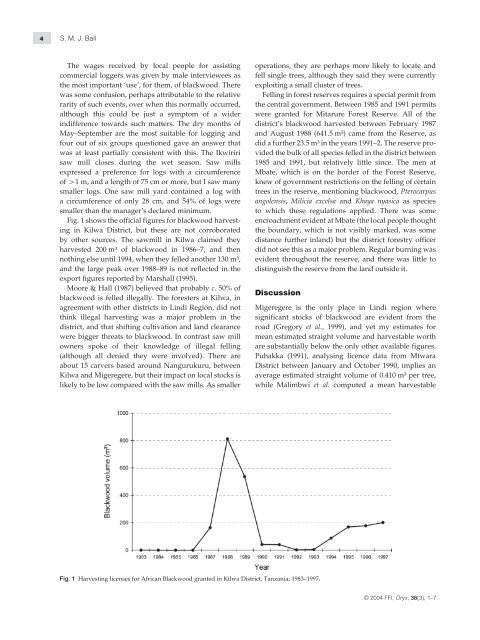Stocks and exploitation of East African blackwood - The Mpingo ...
Stocks and exploitation of East African blackwood - The Mpingo ...
Stocks and exploitation of East African blackwood - The Mpingo ...
Create successful ePaper yourself
Turn your PDF publications into a flip-book with our unique Google optimized e-Paper software.
4 S. M. J. Ball<br />
<strong>The</strong> wages received by local people for assisting<br />
commercial loggers was given by male interviewees as<br />
the most important ‘use’, for them, <strong>of</strong> <strong>blackwood</strong>. <strong>The</strong>re<br />
was some confusion, perhaps attributable to the relative<br />
rarity <strong>of</strong> such events, over when this normally occurred,<br />
although this could be just a symptom <strong>of</strong> a wider<br />
indifference towards such matters. <strong>The</strong> dry months <strong>of</strong><br />
May–September are the most suitable for logging <strong>and</strong><br />
four out <strong>of</strong> six groups questioned gave an answer that<br />
was at least partially consistent with this. <strong>The</strong> Ikwiriri<br />
saw mill closes during the wet season. Saw mills<br />
expressed a preference for logs with a circumference<br />
<strong>of</strong> >1 m, <strong>and</strong> a length <strong>of</strong> 75 cm or more, but I saw many<br />
smaller logs. One saw mill yard contained a log with<br />
a circumference <strong>of</strong> only 28 cm, <strong>and</strong> 54% <strong>of</strong> logs were<br />
smaller than the manager’s declared minimum.<br />
Fig. 1 shows the <strong>of</strong>ficial figures for <strong>blackwood</strong> harvesting<br />
in Kilwa District, but these are not corroborated<br />
by other sources. <strong>The</strong> sawmill in Kilwa claimed they<br />
harvested 200 m³ <strong>of</strong> <strong>blackwood</strong> in 1986–7, <strong>and</strong> then<br />
nothing else until 1994, when they felled another 130 m³,<br />
<strong>and</strong> the large peak over 1988–89 is not reflected in the<br />
export figures reported by Marshall (1995).<br />
Moore & Hall (1987) believed that probably c. 50% <strong>of</strong><br />
<strong>blackwood</strong> is felled illegally. <strong>The</strong> foresters at Kilwa, in<br />
agreement with other districts in Lindi Region, did not<br />
think illegal harvesting was a major problem in the<br />
district, <strong>and</strong> that shifting cultivation <strong>and</strong> l<strong>and</strong> clearance<br />
were bigger threats to <strong>blackwood</strong>. In contrast saw mill<br />
owners spoke <strong>of</strong> their knowledge <strong>of</strong> illegal felling<br />
(although all denied they were involved). <strong>The</strong>re are<br />
about 15 carvers based around Nangurukuru, between<br />
Kilwa <strong>and</strong> Migeregere, but their impact on local stocks is<br />
likely to be low compared with the saw mills. As smaller<br />
operations, they are perhaps more likely to locate <strong>and</strong><br />
fell single trees, although they said they were currently<br />
exploiting a small cluster <strong>of</strong> trees.<br />
Felling in forest reserves requires a special permit from<br />
the central government. Between 1985 <strong>and</strong> 1991 permits<br />
were granted for Mitarure Forest Reserve. All <strong>of</strong> the<br />
district’s <strong>blackwood</strong> harvested between February 1987<br />
<strong>and</strong> August 1988 (641.5 m³) came from the Reserve, as<br />
did a further 23.5 m³ in the years 1991–2. <strong>The</strong> reserve provided<br />
the bulk <strong>of</strong> all species felled in the district between<br />
1985 <strong>and</strong> 1991, but relatively little since. <strong>The</strong> men at<br />
Mbate, which is on the border <strong>of</strong> the Forest Reserve,<br />
knew <strong>of</strong> government restrictions on the felling <strong>of</strong> certain<br />
trees in the reserve, mentioning <strong>blackwood</strong>, Pterocarpus<br />
angolensis, Milicia excelsa <strong>and</strong> Khaya nyasica as species<br />
to which these regulations applied. <strong>The</strong>re was some<br />
encroachment evident at Mbate (the local people thought<br />
the boundary, which is not visibly marked, was some<br />
distance further inl<strong>and</strong>) but the district forestry <strong>of</strong>ficer<br />
did not see this as a major problem. Regular burning was<br />
evident throughout the reserve, <strong>and</strong> there was little to<br />
distinguish the reserve from the l<strong>and</strong> outside it.<br />
Discussion<br />
Migeregere is the only place in Lindi region where<br />
significant stocks <strong>of</strong> <strong>blackwood</strong> are evident from the<br />
road (Gregory et al., 1999), <strong>and</strong> yet my estimates for<br />
mean estimated straight volume <strong>and</strong> harvestable worth<br />
are substantially below the only other available figures.<br />
Puhakka (1991), analysing licence data from Mtwara<br />
District between January <strong>and</strong> October 1990, implies an<br />
average estimated straight volume <strong>of</strong> 0.410 m³ per tree,<br />
while Malimbwi et al. computed a mean harvestable<br />
Fig. 1 Harvesting licenses for <strong>African</strong> Blackwood granted in Kilwa District, Tanzania, 1983–1997.<br />
© 2004 FFI, Oryx, 38(3), 1–7
















